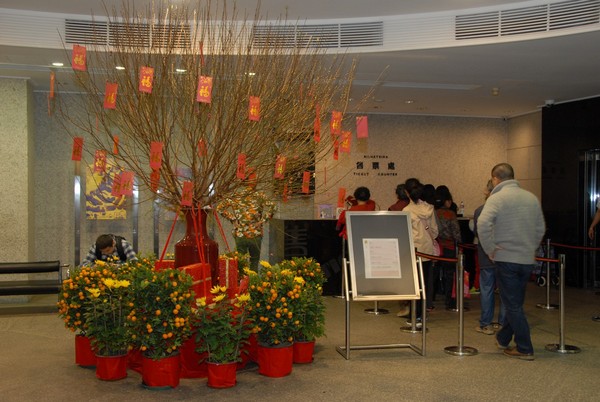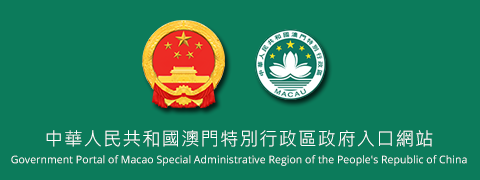Macao SAR Government Portal
News
CE’s New Year Message: join hands to build a better Macao

The Chief Executive, Mr Chui Sai On, today called on the people to join hands to help build a better Macao in the Year of the Horse. The Government would continue to implement the long-term effective mechanisms and join hands with the people to build a better Macao to achieve fruitful prospects, Mr Chui said in his Lunar New Year Message. But we have to stay alert for the existing challenges, he said. In reminiscence the Year of Snake, Mr Chui said Macao's economy had grown steadily and people's livelihood had improved: constitutional development has also been carried forward in an orderly manner. In the New Year that begins tomorrow, Mr Chui said the Government would speed up building Macao as the world tourism leisure hub and the business and trading service platform for China and the Portuguese-speaking countries. He reminded the people to remember to care for and help socially vulnerable groups and share our happiness with them in these festive days. Mr Chui also thanked civil servants and those who had to work over the holidays: he wished everyone a happy, healthy and prosperous New Year.
…
Transport and Communications Statistics for 2013
Information from the Statistics and Census Service (DSEC) indicated that the total number of licensed motor vehicles reached 227,937 at the end of 2013, up by 5% year-on-year, of which motorcycles and light private cars accounted for 52% and 41% respectively. New registration of motor vehicles increased by 9% year-on-year to 19,143 in 2013, with light private cars and motorcycles sharing 49% and 45% of the total. For the whole year of 2013, number of traffic accidents totalled 15,077 cases, up by 3% year-on-year, resulting in 5,290 victims and 19 of them were killed. Cross-border vehicle traffic by land between Macao and Mainland China reached 4,658,186 vehicle trips in 2013, up by 4% year-on-year, of which vehicle traffic through the Border Gate accounted for 81%. Meanwhile, passenger ferry between Macao and Hong Kong and between Macao and Mainland China totalled 138,342 ferry trips in 2013, down marginally by 1% year-on-year, with those between Macao and Hong Kong sharing 79% of the total. Commercial flight movements at the Macao International Airport increased by 16% year-on-year to 44,917 in 2013, of which flight movements to and from Mainland China accounted for 38%, up by 20% year-on-year. Helicopter flights between Macao and Hong Kong and between Macao and Mainland China totalled 17,285, down by 6% year-on-year, with those between Macao and Hong Kong accounting for 81% of the total. For the whole year of 2013, seaborne container throughput totalled 124,973 TEU, equivalent to 89,494 containers handled, up by 4% and 2% respectively year-on-year. Gross weight of seaborne containerized cargo decreased by 6% to 194,638 tonnes, with 6,122 tonnes of transshipment goods. Gross weight of containerized cargo by land dropped by 6% year-on-year to 28,827 tonnes, including 9,355 tonnes of transit goods. In 2013, outward air cargo (15,019 tonnes) decreased by 8% year-on-year while inward air cargo (6,434 tonnes) increased slightly by 1%. Transit air cargo decreased by 2% to 4,968 tonnes. At the end of 2013, number of mobile telephone users increased by 7% year-on-year to 1,722,245, whereas fixed-line telephone users decreased by 3% to 158,414. As regards internet services, number of subscribers totalled 262,863 and the cumulative duration of usage reached 814 million hours in 2013, up by 14% and 20% respectively year-on-year.
…
Mandarin’s House Cultural Relics Info Center and Gift Shop remains open during Chinese New Year

Aiming to offer local cultural and creative entities more showcase and sales platforms, and allow tourists and residents to become better acquainted with these entities, the Cultural Affairs Bureau has set up the Mandarin's House Cultural Heritage Info Center and Gift Shop. Every year, the CAB selects, from the Database for Cultural and Creative Industries, a number of entities to associate with this shop, where they can promote and sell a variety of products. This year, 19 cultural and creative entities mark their presence at the Gift Shop, having already recorded good sales in the first month. The Gift Shop will remain open as usual during Chinese New Year. The Gift Shop carries a great diversity of products, selling books and publications, pop music, handicrafts and creative products, but also featuring Mandarin's House themed souvenirs, books written by or on renowned Chinese philosopher Zheng Guanying and publications by the CAB, as well as Macao World Heritage design products. In 2014, the 19 cultural and creative units present at the Gift Shop include: Casa de Artesanato Nam Fan Lou, Macau Creations Limited, Macau Sky & Earth Ceramic Art Association, Macao Heritage Ambassadors Association, San Seng Fung, Macao Daily News, Associação de Ciências Humanas de Macau, Chinese Cultural Industries Association of Macao, Chan Kam Lun, Macau Association of Composers, Macau Authors & Publishers, Chinese Language Media & Culture Association, Dream Project Association, 100 Plus Music Ltd., Smith's creation, Silver One's, Wong Iok Kun, Macau Handcraft and Creative People Association, Chang Chi Ching, and i.Be Kwong. Based on the Database for Macao Cultural and Creative Industries, the CAB plans to annually select companies to be present at the shop and commercialize their own creative branded products on consignment. The call for entries is open to all Macao cultural and creative companies supplying original "Made in Macau" products, be it design items, anime and comic products, or audio and visual products as well as printed materials. The selection criteria includes originality, industrial and market potential, brand image quality, capacity for sustainable development or R&D (Research and Development) and relevance to the Mandarin House theme. The selection will be made upon a comprehensive evaluation of all these factors. The Gift Shop aims to create an extra window and sales platform for local cultural and creative industries, thus publicizing and supporting the development of cultural and creative products with Macau features. Companies not yet listed on the Database are advised to submit their application. Application forms for the Database for Macao Cultural and Creative Industries can be downloaded from www.icm.gov.mo/dpicc or www.macaucci.com.
…
Consumer Council publishes Consumer Report no.244 Consumer Council announces ‘Code of Practice’ for watch retail industry
In its latest issue of Consumer Report, Consumer Council announces the new 'Code of Practice' for the watch retail industry. This is the 16th 'Code of Practice' set up by the Council for its 'Certified Shops', and those of the watch retail industry should comply with the Code. There are over 90 'Certified Shops' belonging to the watch retail industry. Due to the disputes and misunderstandings arising these few years involved with watch retails, the Council set up the 'Code of Practice' for the watch retail industry to state clearly in advance the responsibility of retailers, the rights of both the buyer and the seller, and the characteristics of watch components. The Council indicates that different Codes for other industries have been running successfully for years and the Code for the watch retail industry is believed to strengthen consumers' confidence in watch retailers and the quality of products. The 'Code of Practice' for the watch retail industry can be found in Consumer Report issue no.244. The Council adds that those watch retailers belonging to the 'Certified Shops' mechanism have promised to comply with this Code, any violation of this Code by the industry will lead to penalties in the annual assessment of 'Certified Shops'. Watch retailers which do not belong to the 'Certified Shops' mechanism are also welcome to use this Code. The Council will prepare promotional leaflets in Chinese, Portuguese, and English at a later stage for both retailers and consumers. The latest issue no. 244 Consumer Report also includes features on the exhibition of 'Consumer Arbitration Centre' in local tertiary institutes, and advices for consumers on how to be more environmental friendly during holiday times. Consumer Report is now available free of charge at the Consumer Council (Av. Horta e Costa, N.º 24-A, Edf. Cheung Heng, R/C), and the service counter of the Council at Macao SAR Government Service Centre (Rua Nova da Areia Preta, Nº52), Public Information Centre at Vicky Plaza, libraries and bookstores. Consumers may also access the magazine online on the Council's official website (http://www.consumer.gov.mo). For enquiries, please call 8988 9315.
…
Macao Museum Welcomes Citizens during Chinese New Year Holidays

The Macao Museum and its affiliated galleries, under the Cultural Affairs Bureau - including the Museum of Sacred Art and Crypt, Kun Iam Ecumenical Centre, Mount Fortress Corridor and Guia Chapel located in Guia Fortress - will be open to the public on Chinese New Year's Eve (30 January) as well as during Chinese New Year (31 January to 2 February) as usual. The Heritage Exhibition of a Traditional Pawnshop Business will close on the first day of Chinese New Year (31 January) but will open on the second and third days of Chinese New Year (1 and 2 February) as per usual. The Macao Museum and the Heritage Exhibition of a Traditional Pawnshop Business will close on the fourth day of Chinese New Year (3 February). The Macao Chinese Orchestra will perform a Chinese New Year concert on 7 February at 6pm at the Kun Iam Ecumenical Centre. It will also perform in the main hall of the Macao Museum on 25 February at 12pm. Admission to both performances is free. Places are limited and available on a first come, first served basis. In addition, the Museum will hold a book launch ceremony on 12 February at 5:45pm in its auditorium for 500 Years of Italians in Hong Kong & Macau, recommended by the Consulate General of Italy in Hong Kong and Macao, and Portrait of a Jesuit - Alessandro Valignano, published by the Macau Ricci Institute. The three exhibition projects co-hosted by the Macao Museum within the framework of the Greater Pearl River Delta Cultural Co-operation Meeting are either currently running or will tour Guangdong and Hong Kong. "Maritime Porcelain Road: Relics from Guangdong, Hong Kong and Macao Museums" will be exhibited at the Hong Kong Museum of Art until 16 February, while "Historical Imprints of Lingnan: Major Archaeological Discoveries of Guangdong, Hong Kong and Macao" recently opened at Guangdong Museum and will run until 28 March. In addition, the joint exhibition "Tranquil Life: Relics of Sun Yat Sen's Second Daughter Sun Wan and her Husband Dai En Sai Collected in Guangdong, Hong Kong and Macao" can be visited at the Guangdong Museum of Revolutionary History in Guangzhou from 17 February. To celebrate this festive season, from the first to the third day of the New Year, Macao residents and students can visit the Macao Museum free of charge by presenting their ID or Macao student cards. The Macao Museum is open from 10am to 6pm (tickets available until 5:30pm). For more information on the opening hours of the aforementioned museums, please call (853) 2835 7911, during office hours, or visit www.macaumuseum.gov.mo and www.icm.gov.mo.
…
Consumer Council announced total number of cases received in 2013 Complaint cases dropped to almost 1,700
Consumer Council received a total of 7,198 cases last year. There were 1,666 complaints, 5,475 inquiries, and 57 suggestions. The total number of cases of the top 5 categories of complaints amounted to 727, which was about 43.6 percent of the total. The top 5 categories were telecommunication services (209 cases), telecommunication equipment and supplies (201 cases), food and beverages (143 cases), electrical appliances (90 cases), and tourism (84 cases). The number of complaint cases of telecommunication services has dropped by about 12.5 percent compared to last year, the reason for reduction in cases was improved measures taken by telecommunication service providers after taken in advices by the Council. Obvious increases of complaint cases were observed in categories such as food and beverages and tourism, both recorded an increase of about 15 percent and 35 percent respectively. For food and beverages, complaints were mainly about milk powder, 25 of which involved the sale tactics of milk powder retailers and the prices of milk powder. For tourism, 84 complaints were received, issues about unsatisfactory outbound travel, service quality of hotels, and refused booking at local hotel rooms were involved. The Council indicated that the high frequency of both outbound and inbound traveling played an important role in the increase of number of cases received. The Council will pay attention to the cases received and follow up timely to safeguard consumer rights. A total number of 843 cases were received from tourists last year and 338 of which were complaints. In comparison to the numbers of 2012, number of complaint cases had dropped by over 6 percent (361 cases in 2012). The top categories were telecommunication equipment and supplies, watches, clothing and apparel, photographic equipments, etc. The Council indicated that the number of complaint cases from tourists had dropped consecutively for two years while inquiries from tourists (505 cases in 2013) keep on increasing, showing that the increased promotional work done by the Council helped tourists to be aware of the differences in buying behaviours in different regions, and to know that making inquiries in advance prevent consumer disputes. A detailed analysis of the number of cases received in 2013 will be published later by the Council in its monthly magazine Consumer Report.
…
Consumer Council released its latest ‘Supermarket price survey’ in Taipa Area
Consumer Council conducted its 'Supermarket price survey' for January on 27th January for the implementation of Section 2b), Article 10, Law 4/95/M of 12th June. Surveyed locations included 11 supermarkets in Taipa area. The latest 'Supermarket Price Survey' is now available on Consumer Council's website (www.consumer.gov.mo), and the 'Supermarket Price Information Platform' iPhone and Android apps. The survey is also available free of charge at the offices of Consumer Council, IACM's Iao Hon and S. Domingos Markets, bookstores and libraries. Consumers may also access the resources through WAP channels on their mobile phones. With reference to the local six parishes and the number of supermarkets in each parish, the Council has divided around 100 supermarkets into 8 areas for price collection. The Council collects prices from these supermarkets for the provision of a more comprehensive database for consumers to check price discrepancies and make price comparisons according to their desired locations. For inquiry, please call 8988 9315.
…
MGTO activates preparation for Spring Festival Golden Week

Spanning a week from 31 January to 6 February, the Spring Festival Golden Week is about to begin. Macau Government Tourist Office (MGTO) is actively preparing for the peak period in various ways by activating the tourism notification system, increasing inspection duties, sending reminders to the trade about various concerns, printing local food guide and carrying out a range of Lunar New Year celebrations, etc. The Office strives not only to cater for citizens and visitors' needs but also to optimize local tourism environment and service quality through various measures. MGTO and Tourism Administration of Guangdong Province have officially activated the "Tourism Notification System for Spring Festival Golden Week" on 27 January until 7 February to ensure smooth hospitality work for visitors during Lunar New Year. MGTO will release related information online, including the updated numbers of Mainland and overall visitor arrivals at various ports every previous day. The two destinations' tourism authorities will keep close communication with each other. MGTO has been regularly releasing the room rates of Macau hotels and guest houses in different room categories on its website so that visitors can obtain the latest information. The Office will also send Wechat and mobile text messages to Mainland residents who plan to visit Macau during the Golden Week, advising them to make room reservation in advance and to check hotel room rates on MGTO's website if needed; To ensure visitors have more travel tips in hand, the Office also encourages visitors to download travel information before their departure for Macau or to obtain printed materials at MGTO's Tourist Information counters for free upon arrival. Moreover, MGTO will take more frequent action to inspect different tourist spots, border ports and areas in Macau and increase the manpower at Tourist Information counters during Spring Festival. MGTO's tourism hotline (853) 2833 3000 will maintain its 24-hour operator service to answer tourists' enquiries. The Office's inspectors will also stand by round-the-clock to cope with any situation when visitors are in need. Visitors can visit MGTO's website for further travel information. MGTO has also sent letters reminding the trade to concern about hygiene, fire safety, opening hours, occupational guidelines of hosting tour groups, requirements regarding report of hotel room rates and record of hotel guest information upon check-in, etc. MGTO also regularly communicates and exchanges news with Consumer Council, Public Security Police Force, Macau Customs Service, Marine and Water Bureau, Transport Bureau and so forth. Visitors can visit Public Security Police Force's website: www.fsm.gov.mo/psp/pspmonitor on phone or computer and check the real-time border-crossing images at the arrival/departure halls and traffic lanes of Barrier Gate, Outer Harbour and Cotai Frontier Post on the "Real-Time Information Platform of Border Ports", thus choosing the right timing to leave or arrive in Macau. MGTO's website offers a direct link to Public Security Police Force's webpage for the "Real-Time Information Platform of Border Ports". Besides the above measures, MGTO also jointly publishes "Macau Food Guide during Spring Festival" (Chinese version only) with The United Association of Food and Beverage Merchants of Macau, The Industry and Commerce Association of Macau Northern District, General Union of the Macau Neighborhood Association as well as The Industry and Commerce Federation of Islands of Macau. The food guide offers a contact list of restaurants and eateries which will open during Spring Festival for visitors to obtain their operating information conveniently. To give citizens and visitors a pleasant experience in town, MGTO is presenting a series of events during Spring Festival including "Parade of Gigantic Golden Dragon", "Parade for the Celebration of the Year of the Horse" and "Fireworks Display for the Celebration of 2014 Chinese New Year". Special festivities will be held along the four walking tour routes of the project "Step Out, Experience Macau's Communities" as well. The five Macau Tourism Ambassadors will be there with other staff to answer visitors' enquiries and introduce them to various tourist spots along the routes. They will also distribute the brochure "Step Out, Experience Macau's Communities", encouraging locals and visitors to explore the routes. "Macau Food Guide during Spring Festival", the "Step Out, Experience Macau's Communities" brochure and Chinese New Year Festivities Program can be downloaded from MGTO's website: www.macautourism.gov.mo or acquired from various Tourist Information counters of MGTO.
…
MGTO unveils brand-new Tourist Information counter to present innovative image and quality service

Macau Government Tourist Office (MGTO) has carried out a big renovation project to remodel its Tourist Information counter at Macau Ferry Terminal since last year. The revamped Tourist Information counter will officially come into operation tomorrow (28 January). The new information counter manifests a brand-new image with its open-style design and offers a wider and cozy environment for visitors. Presenting a series of thoughtful and cutting-edge facilities, the new counter serves to provide quality service for visitors and show warm hospitality. MGTO Director Maria Helena de Senna Fernandes and related department supervisors introduced the brand-new facilities of the Tourist Information counter at Macau Ferry Terminal today (27 January). There are not only personnel attending to visitor enquiries but also a range of multi-media equipment for visitors to explore useful travel information at the open-style counter. Facilities and space are also designed for disabled visitors to ensure greater convenience at the counter. Brilliant image in red and white hues The main tone of the renovated Tourist Information counter comprises brilliant red and white color in harmony with bright and natural light installations, eco-friendly architectural design and thoughtful equipment, which together creates a sense of cozy home for visitors. Overflowing with Portuguese aroma, the black-and-white brick floor in wave patterns manifests Macau's unique cultural background. A 1.7-meter x 3-meter mega LED screen is installed at the back area of the information counter to show MGTO's promotional videos and photos as well as related videos during major events and festivals. A light box is set up for event posters and so on at the information counter's glass wall which faces the entrance of the ferry terminal. Modern design shows thoughtfulness The open-style design enables the service counter at Tourist Information to make better use of the available space than before. The service counter is equipped with three multi-media interactive screens for visitors to search for travel information they need, including restaurants and snack shops, hotels and guest houses, heritage and culture, walking routes, map, leisure and entertainment, shopping, locations with free-wifi service and mobile apps for download, etc. One of the interactive screens is designed for disabled visitors. Visitors can also instantly send any information about tourist spots or facilities to their own mailbox via e-mail. In the near future, the QR Code function will also be available for visitors to scan QR codes by using their Smartphone with camera function and directly link to the related websites. Moreover, two vertical multi-media interactive screens are installed outside the Tourist Information counter for 24-hour operation so that visitors can obtain useful travel information at the Tourist Information counter during non-office hours as well. One of the vertical screens offers monthly event highlights from "What's On" publication as well as other choices of leisure and entertainment in town such as family fun and spa; whereas the other screen shows event posters and typhoon news during the time when typhoon is hoisted in Macau. All the multi-media interactive screens provide information in English, Portuguese, Traditional and Simplified Chinese language, while the "What's On" news is available in English, Traditional and Simplified Chinese. In line with the traditional way of material obtainment, display racks are set up at both sides of the service counter at Tourist Information to hold tourism brochures, promotion flyers and publications for visitors to choose any printed materials they need easily. Another computer screen is present at the counter to show real-time information at various border ports provided by Public Security Police Force. A storage room and a staff working room are located at the rear of Tourist Information counter as well; the latter is for staff to handle daily internal duties. MGTO currently operates eight Tourist Information counters for visitors to obtain Macau travel info, six of which are located at different locations in Macau including Ritz Building at Senado Square, Macau Ferry Terminal, Barrier Gate, Macau International Airport, Macau Fisherman's Wharf and Taipa Temporary Ferry Terminal while the other two counters are situated at Hong Kong International Airport and Shun Tak Center in Hong Kong. Last year MGTO's Tourist Information counters attended to over 1.27 million visitor enquiries. MGTO will begin other renovation projects at Tourist Information counters this year. In addition, MGTO has been providing visitors with Macau travel information through a variety of channels including MGTO's website, travel guide, free monthly publication "What's On", audio guiding service and mobile applications, etc. In the future, the Office will keep optimizing its tourist information facilities to ensure visitors can promptly obtain useful travel tips prior to their trip and during their stay in Macau.
…
Consumer Council and other departments met up to prepare for Chinese New Year
As Lunar New year, a traditional peak shopping season, is coming, Economic Services Bureau (DSE), Macao Government Tourist Office (DST), Transport Bureau (DSAT), Judiciary Police (PJ), Public Security Police Force (PSP), Macao Custom Service, Civic and Municipal Affairs Council (IACM) and Health Bureau (SS) were called for a meeting to discuss on the protection of consumer rights for inbound tourists and measures against 'unscrupulous shops'. Consumer Council reminds consumers that if anyone finds his or her consumer rights being infringed, he or she should file a complaint at the Council or other departments and provide all necessary detailed information. The Council will also assign its staff to provide services to consumers through its hotline during 11AM to 6PM each day during Chinese New Year holidays (1st to 4th February). Consumer Council hotline: 8988 9315.
…

